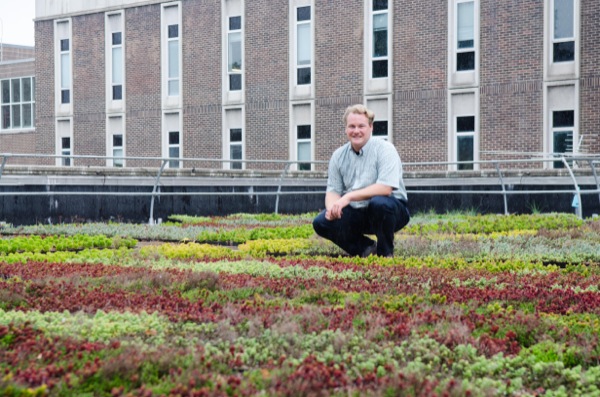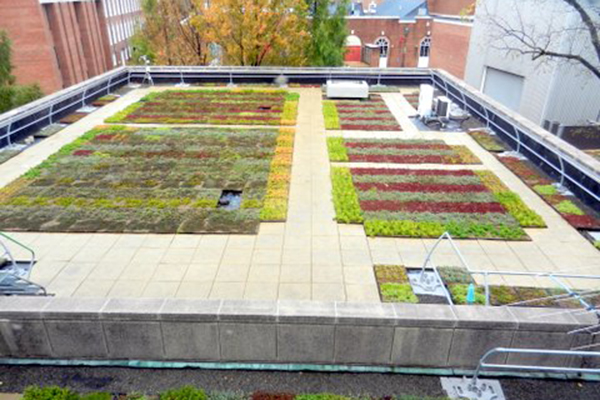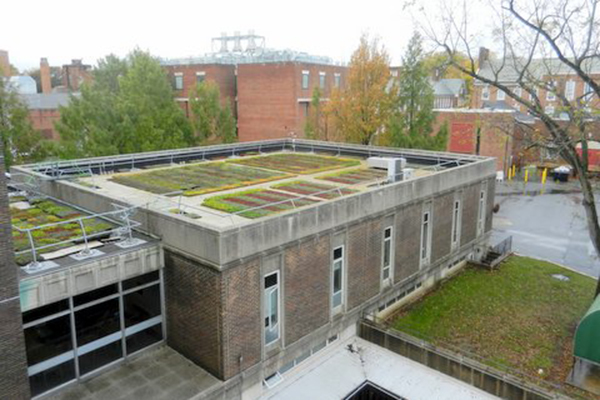Green roof
Members of UD, Delaware community celebrate green roof completion
3:22 p.m., Oct. 2, 2012--U.S. Sen. Tom Carper and members of the Delaware community joined University of Delaware students and faculty on Friday, Sept. 28, at Colburn Laboratory to celebrate the completion of the University’s first green roof on a classroom building.
The environmentally friendly green roof was made possible thanks to grant funding and some unique engineering by the school’s landscape design program.
Campus Stories
From graduates, faculty
Doctoral hooding
“This new green roof project at the University of Delaware is a great example of the power of public-private partnerships,” Carper said. “With support from the state of Delaware, DuPont and the University of Delaware, this project is helping to lower energy use, clean the air and teach sustainable environmental practices to future generations at the same time.”
Mark Rieger, dean of the College of Agriculture and Natural Resources (CANR), said at the celebration, “It’s great to see horticulture — and I’m speaking as a horticulturist now — come to the intersection of engineering and art.”
Chad Nelson, assistant professor of landscape design, thanked all of those who helped the project along the way. “I knew when we started that we could do this, that we could get a green roof on campus but I knew that it wouldn’t be easy,” said Nelson. “I really want people to see the roof and think of other places on campus or in the community where people might be interested in starting new projects. Green roofs, while they aren’t the entire answer, really are a beautiful and effective way of helping us to address some serious issues.”
About 600 engineering students take classes in the Colburn Lab’s one-story classroom wing, where indoor temperatures have been known to reach 86 degrees due to heat transfer from its southern exposure, wide expanses of glass and flat roof. Installing reduced wattage lights, ventilation maintenance and other measures failed to reduce temperatures to levels low enough for learning.
Among the chronically overheated were Annette Shine, associate professor of chemical and biomolecular engineering, and her teaching assistant, Kathy Phillips, who thought a green roof might make a cost-effective and environmentally-friendly difference.
They connected with Nelson and student Aaron Hallett who were interested in starting a green roof project on campus.
The resulting green roof plan offers a variety of environmental, educational and fiscal benefits such as:
- An insulating effect, with 4-inch deep plantings reducing the temperature of the roof and keeping the classrooms and occupants below cooler by six degrees or more;
- Reduction of carbon dioxide emissions by reducing demand on building HVAC systems;
- A sponge effect, absorbing storm water runoff to improve water quality in nearby waterways;
- A teaching tool, allowing engineering students to study “green engineering” solutions in a living classroom;
- An opportunity for students to get hands-on experience in growing the plants and installing the system;
- A less costly option than replacing the building’s HVAC, reduced energy costs from operating the existing system with less demand -- and a more attractive view from the three-story portion of the building overlooking the roof.
Built in the 1960s, the one-story building had been originally designed to have additional stories added later, so an initial study found the existing roof structure could support the additional weight.
With that key question answered, the project moved forward, with total costs of $72,000. The project received a $40,000 Regional Greenhouse Gas Initiative (RGGI) program grant, administered by the Delaware Department of Natural Resources and Environmental Control’s Division of Energy and Climate, plus a $10,000 from the DuPont Clear into the Future program for environmentally-beneficial projects protecting the Delaware Estuaries and $5,000 each from two UD programs, the University of Delaware Energy Institute and the University of Delaware Sustainability Fund.
Instead of using a membrane system that would cover the whole roof, Nelson opted for a modular system consisting of 2-foot by 2-foot plastic trays that could be installed by students and volunteers and moved for roof maintenance. A safety railing was installed around the roof edge, along with a locking door for roof access.
Beginning last spring, students from CANR propagated heat-hardy plants including several varieties of colorful sedum, plus chives and crocus. The students then established them in the trays with help from local Girl Scouts and began moving them to the roof into a pattern that echoes the layout of the building below.
Article by Adam Thomas
Photos by Danielle Quigley













